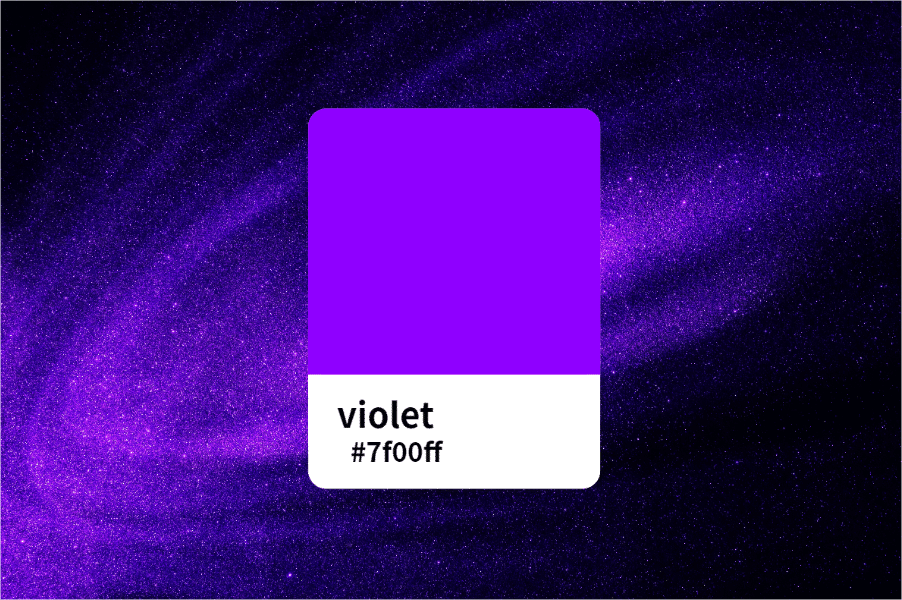
Violet is a color that has held significance for centuries. From its deep, rich hue to its symbolic meanings, violet stands out in the world of color. While many people associate violet with beauty and elegance, it carries a deeper significance that goes beyond mere aesthetics. In this blog post, we will explore the history, symbolism, and cultural significance of the color violet. Whether you’re fascinated by its historical roots or interested in how it affects modern-day design, violet has something for everyone.
What is Violet?
Violet is a color that falls between blue and purple on the color spectrum. It’s a unique blend that combines the calmness of blue with the passion of red, giving it both a cool and warm appeal. The color can range from light lavender to a deeper, darker shade closer to purple. In terms of light, violet is produced by mixing red and blue wavelengths, making it a color that evokes both tranquility and energy.
While violet is often confused with purple, the two colors have subtle differences. Purple is generally a mixture of red and blue, while violet tends to have a stronger blue influence. In art, both colors are used for a variety of purposes, but violet’s unique properties make it particularly striking when incorporated into design.
The Symbolism of Violet
Throughout history, violet has carried rich symbolism in many cultures. Its meanings have evolved, but it has always been associated with certain traits. Here are some of the most significant symbolic meanings of violet:
1. Royalty and Nobility
One of the oldest associations of violet is its connection to royalty. In ancient times, the dye used to produce purple and violet colors was extremely rare and expensive. This made the color exclusive to the rich and powerful. It was often worn by kings, queens, and emperors, symbolizing wealth, power, and high social status.
Violet’s historical ties to nobility have persisted into modern times, and it remains associated with sophistication and luxury. In fashion and design, violet remains a popular choice for evoking a sense of grandeur and elegance.
2. Spirituality and Mysticism
Violet is also strongly linked to spirituality and mysticism. In many religious and spiritual traditions, violet is considered a sacred color. In Christianity, for example, violet is used during the season of Lent to represent penance and humility. The color is seen as a bridge between the material world and the spiritual realm.
In the realm of New Age practices, violet is often associated with the Crown Chakra, which is believed to represent higher consciousness and enlightenment. This connection to higher realms and the divine has made violet a color often used in meditation and healing practices.
3. Creativity and Imagination
Violet is a color often linked with creativity and artistic expression. It’s a color that stimulates the imagination and encourages innovative thinking. For many artists, violet is an essential part of their palette, used to evoke mood, convey emotion, and add depth to their work.
Because it blends the calming nature of blue with the fiery energy of red, violet can spark both contemplation and inspiration. Many people find that working in a violet-infused environment helps unlock their creativity and enhances their problem-solving abilities.
Violet in Nature
Violet isn’t just a color used in fashion or art—it’s also a prominent color in the natural world. Some of the most beautiful flowers and plants display shades of violet, including:
1. Violets (the Flower)
The violet flower, from which the color gets its name, is often seen as a symbol of love, modesty, and simplicity. The soft purple petals of the violet flower have long been admired for their delicate beauty. In the language of flowers, also known as floriography, violets represent modesty and faithfulness.
The violet flower is also popular in various forms of traditional medicine. Its petals are known for their medicinal properties, including their use in teas to soothe coughs or inflammation. The flower’s symbolism as a symbol of humility has made it a favorite in gardens and floral arrangements worldwide.
2. Lavender Fields
Lavender is another plant that displays beautiful violet hues. The calming fragrance of lavender has made it a favorite in aromatherapy, often used for relaxation and stress relief. Lavender fields are particularly famous for their breathtaking sight, as rows upon rows of vibrant violet flowers stretch as far as the eye can see.
Lavender, like the color violet, is linked to tranquility and peace. The soothing fragrance and color of lavender have made it a beloved plant for creating serene spaces both indoors and outdoors.
Violet in Modern Culture
Violet has found its place in modern culture and design. Whether it’s in interior decor, fashion, or branding, violet continues to be a color that stands out. Let’s examine the role of violet in contemporary life.
1. Violet in Fashion
Violet is often used in fashion to make a bold statement. Designers frequently incorporate varying shades of violet to create unique, attention-grabbing outfits. The color’s rich, regal qualities make it ideal for evening wear and formal attire, where it conveys sophistication and class. Additionally, violet is often used in fashion to represent creativity and individuality, particularly by avant-garde designers.
2. Violet in Interior Design
In interior design, violet is often used to add a sense of luxury and elegance to a space. Lighter shades like lavender can create a soft, calming atmosphere in bedrooms and living rooms. Darker hues, like deep purple or plum, can add depth and drama to a room, making it feel both cozy and luxurious.
Whether used in wall paint, furniture, or accessories, violet helps set the mood and tone of a space. Its versatility makes it suitable for both modern and traditional interior designs.
3. Violet in Branding
Several brands use violet to convey creativity, luxury, and innovation. Brands like Yahoo! and Syfy have incorporated violet in their logos and marketing materials to communicate a sense of uniqueness and sophistication. For many companies, using violet in their branding helps differentiate them from competitors and attracts customers who value quality and creativity.

Conclusion: The Lasting Power of Violet
Violet is more than just a color. It’s a symbol of luxury, creativity, spirituality, and the natural world. From the royal courts of ancient times to the modern-day catwalks, violet continues to captivate and inspire. Whether you are drawn to its calming influence, its connection to higher consciousness, or its rich aesthetic qualities, violet will always have a place in both culture and design.
As a color that blends the best of both blue and red, violet offers a unique blend of calming energy and passionate intensity. It’s no wonder it has been revered for centuries and continues to have a profound impact on art, fashion, and society. No matter where you encounter violet—whether in a flower, a piece of artwork, or a piece of clothing—it is sure to leave an impression.





